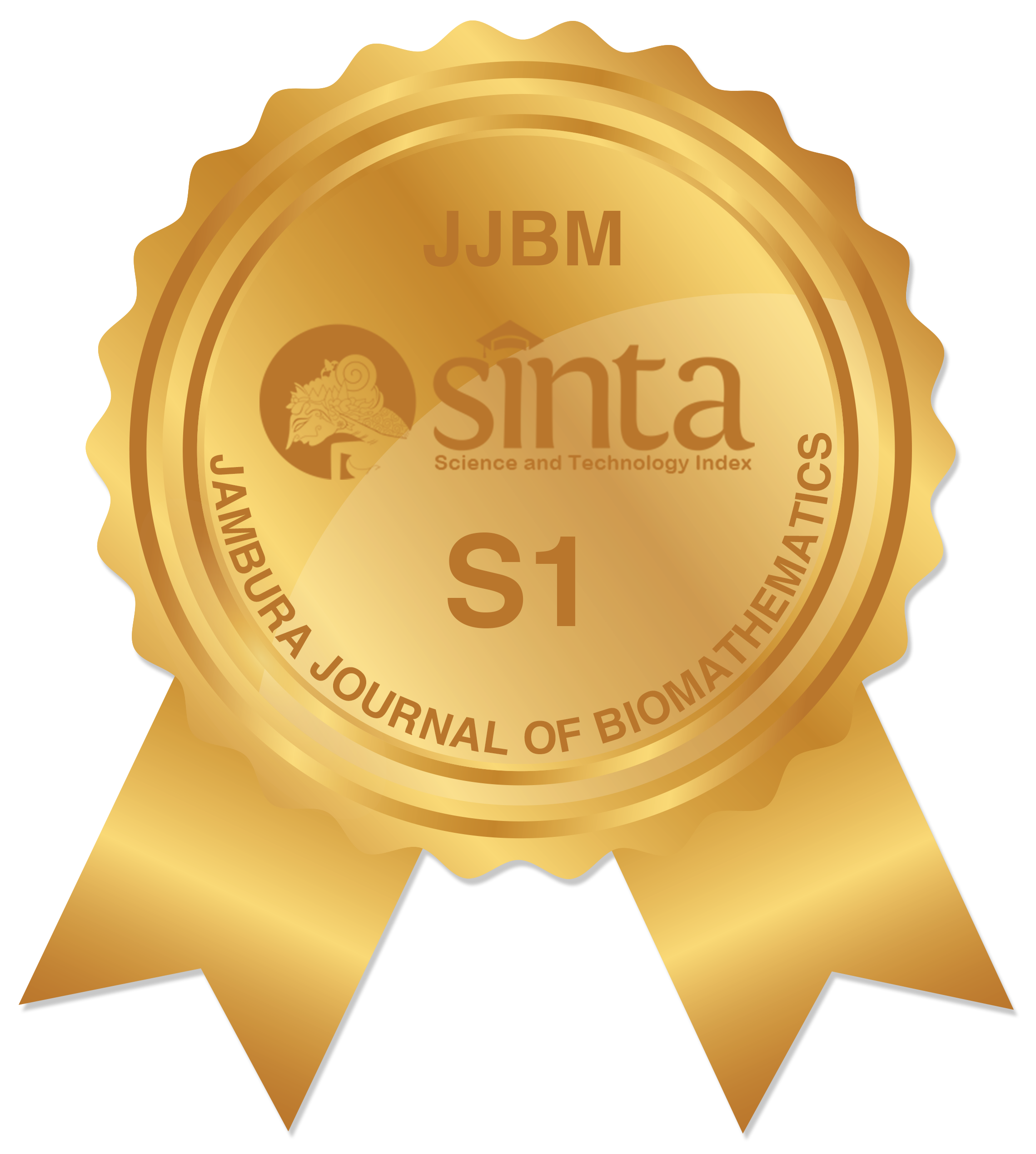Mathematical Model of SAR-CoV-2 and Influenza A Virus Coinfection within Host with CTL-Mediated Immunity
Abstract
Keywords
Full Text:
PDFReferences
BS. Mohan and N. Vinod, "Covid-19: an insight into sars-cov-2 pandemic originated at wuhan city in hubei province of china" Journal of Infectious Diseases and Epidemiology, vol. 6, no. 4, p. 146, 2020. DOI:10.23937/2474-3658/1510146
D. Wu et al., "The sars-cov-2 outbreak: what we know" International journal of infectious diseases, vol. 94, pp. 44-48, 2020. DOI:10.1016/j.ijid.2020.03.004
WHO, "WHO coronavirus (COVID-19)" 2024, https://covid19.who.int/, Accesed on 13 March 2024.
A. Havasi et al., "Influenza a, influenza b, and sars-cov-2 similarities and differences-a focus on diagnosis" Frontiers in Microbiology, vol. 13, p. 908525, 2022. DOI:10.3389/fmicb.2022.908525
M. Moghadami, "A narrative review of influenza: a seasonal and pandemic disease" Iranian journal of medical sciences, vol. 42, no. 1, p. 2, 2017. DOI:10.30476/ijms.2016.40409
R. Scendoni et al., "Leading pathogens involved in co-infection and super-infection with covid-19: forensic medicine considerations after a systematic review and meta-analysis" Pathogens, vol. 12, no. 5, p. 646, 2023. DOI:10.3390/pathogens12050646
N. Kumar et al., "Virological and immunological outcomes of coinfections" Clinical microbiology reviews, vol. 31, no. 4, 2018. DOI:10.1128/CMR.00111-17
N. Teluguakula et al., "Sars-cov-2 and influenza co-infection: Fair competition or sinister combination?" Viruses, vol. 16, no. 5, p. 793, 2024. DOI:10.3390/v16050793
B. E. Dixon et al., "Symptoms and symptom clusters associated with sars-cov-2 infection in community-based populations: Results from a statewide epidemiological study" PLoS One, vol. 16, no. 3, p. e0241875, 2021. DOI:10.1371/journal.pone.0241875
H. Yue et al., "The epidemiology and clinical characteristics of co-infection of SARS-CoV-2 and influenza viruses in patients during COVID-19 outbreak" Journal of medical virology, vol. 92, no. 11, pp. 2870-2873, 2020. DOI:10.1002/jmv.26163
J.-H. Hwang et al., "Influenza viral infection is a risk factor for severe illness in covid-19 patients: a nationwide population-based cohort study" Emerging microbes & infections, vol. 12, no. 1, 2023. DOI:10.1080/22221751.2022.2164215
D. Kim et al., "Rates of co-infection between sars-cov-2 and other respiratory pathogens" JAMA, vol. 323, no. 20, p. 2085, 2020. DOI:10.1001/jama.2020.6266
J. Ca, "The immune system in health and disease" 2001, http://www. garlandscience. com.
A. K. Abbas, A. H. Lichtman, and S. Pillai, Cellular and Molecular Immunology E-Book: Cellular and Molecular Immunology E-Book. Elsevier Health Sciences, 2014.
A. Grifoni et al., "Targets of t cell responses to sars-cov-2 coronavirus in humans with covid-19 disease and unexposed individuals" Cell, vol 181, no. 7, pp. 1489-1501, 2020. DOI:10.1016/j.cell.2020.05.015
N. L. La Gruta et al., "Understanding the drivers of MHC restriction of T cell receptors" Nature Reviews Immunology, vol. 18, no. 7, pp. 467-478, 2018. DOI:10.1038/s41577-018-0007-5
C. Quirouette et al., "A mathematical model describing the localization and spread of influenza a virus infection within the human respiratory tract" PLOS Computational Biology, vol. 16, no. 4, p. e1007705, 2020. DOI:10.1371/journal.pcbi.1007705
B. O. Emerenini et al., "Mathematical Modeling and Analysis of Influenza In-Host Infection Dynamics" Letters in Biomathematics, vol. 8, no. 1, pp. 229-253, 2021. DOI:10.30707/lib8.1.1647878866.124006
P. Krishnapriya, M. Pitchaimani, and T. M. Witten, "Mathematical analysis of an influenza a epidemic model with discrete delay" Journal of Computational and Applied Mathematics, vol. 324, pp. 155-172, 2017. DOI:10.1016/j.cam.2017.04.030
M. Erdem, M. Safan, and C. Castillo-Chavez, "Mathematical Analysis of an SIQR Influenza Model with Imperfect Quarantine" Bulletin of Mathematical Biology, vol. 79, no. 7, pp. 1612-1636, 2017. DOI:10.1007/s11538-017-0301-6
S. Liu, S. Ruan, and X. Zhang, "Nonlinear dynamics of avian influenza epidemic models" Mathematical Biosciences, vol. 283, pp. 118-135, 2017. DOI:10.1016/j.mbs.2016.11.014
K. Koelle et al., "The changing epidemiology of SARS-CoV-2" Science, vol. 375, no. 6585, pp. 1116-1121, 2022. DOI:10.1126/science.abm4915
K. T. Kubra et al., "Analysis and comparative study of a deterministic mathematical model of SARS-COV-2 with fractal-fractional operators: a case study" Scientific Reports, vol. 14, no. 1, p. 6431, 2024. DOI:10.1038/s41598-024-56557-6
A. Weiss, M. Jellingsø, and M. O. A. Sommer, "Spatial and temporal dynamics of SARS-CoV-2 in COVID-19 patients: A systematic review and meta-analysis" EBioMedicine, vol. 58, p. 102916, 2020. DOI:10.1016/j.ebiom.2020.102916
P. Baccam et al., "Kinetics of Influenza A Virus Infection in Humans" Journal of Virology, vol. 80, no. 15, pp. 7590-7599, 2006. DOI:10.1128/JVI.01623-05
R. Syafitri, Trisilowati, and W. M. Kusumawinahyu, "Dynamics of Covid-19 model with public awareness, quarantine, and isolation" Jambura Journal of Biomathematics (JJBM), vol. 4, no. 1, pp. 63-68, 2023. DOI:10.34312/jjbm.v4i1.19832
N. Q. Putri, P. Sianturi, and H. Sumarno, "Sensitivity Analyses of The Dynamics of Covid-19 Transmission in Response to Reinfection" Jambura Journal of Biomathematics (JJBM), vol. 4, no. 1, pp. 15-22, 2023. DOI:10.34312/jjbm.v4i1.18394
H. Nasution et al., "Exploring of Homotopy Perturbation Method (HPM) for Solving Spread of COVID-19" Jambura Journal of Biomathematics (JJBM), vol. 4, no. 2, pp. 138-145, 2023. DOI:10.37905/jjbm.v4i2.21560
F. Firmansyah and Y. M. Rangkuti, "Sensitivity Analysis and Optimal Control of Covid 19 Model" Jambura Journal of Biomathematics (JJBM), vol. 4, no. 1, pp. 95-102, 2023. DOI:10.34312/jjbm.v4i1.19025
S. Chowdhury et al., "Mathematical modelling of COVID-19 disease dynamics: Interaction between immune system and SARS-CoV-2 within host" AIMS Mathematics, vol. 7, no. 2, pp. 2618-2633, 2022. DOI:10.3934/math.2022147
M. M. Ojo et al., "Nonlinear optimal control strategies for a mathematical model of COVID-19 and influenza co-infection" Physica A: Statistical Mechanics and its Applications, vol. 607, p. 128173, 2022. DOI:10.1016/j.physa.2022.128173
A. Elaiw, R. S. Alsulami, and A. Hobiny, "Global dynamics of IAV/SARS-CoV-2 coinfection model with eclipse phase and antibody immunity" Math. Biosci. Eng, vol. 20, no. 2, pp. 3873-3917, 2023. DOI:10.3934/mbe.2023182
S. Halle et al., "In Vivo Killing Capacity of Cytotoxic T Cells Is Limited and Involves Dynamic Interactions and T Cell Cooperativity" Immunity, vol. 44, no. 2, pp. 233-245, 2016. DOI:10.1016/j.immuni.2016.01.010
C. D. Murin, I. A. Wilson, and A. B. Ward, "Antibody responses to viral infections: a structural perspective across three different enveloped viruses" Nature Microbiology, vol. 4, no. 5, pp. 734-747, 2019. DOI:10.1038/s41564-019-0392-y
K. Alligood, T. Sauer, and J. Yorke, Chaos: An Introduction to Dynamical Systems. Springer, 2000.
M. Hajja, "104.17 More proofs of the AM-GM inequality" The Mathematical Gazette, vol. 104, no. 560, pp. 318-326, 2020. DOI:10.1017/mag.2020.59
J. P. Hespanha, "Uniform Stability of Switched Linear Systems: Extensions of LaSalle's Invariance Principle" IEEE Transactions on Automatic Control, vol. 49, no. 4, pp. 470-482, 2004. DOI:10.1109/TAC.2004.825641
T. Carter and M. Iqbal, "The Influenza A Virus Replication Cycle: A Comprehensive Review" Viruses, vol. 16, no. 2, p. 316, 2024. DOI:10.3390/v16020316
B. Abdullah Marzoog, "Cytokines and Regulating Epithelial Cell Division" Current Drug Targets, vol. 25, no. 3, pp. 190-200, 2024. DOI:10.2174/0113894501279979240101051345
J. A. Dudakov, A. M. Hanash, and M. R. van den Brink, "Interleukin-22: Immunobiology and Pathology" Annual Review of Immunology, vol. 33, no. 1, pp. 747-785, 2015. DOI:10.1146/annurev-immunol-032414-112123
S. Peng et al., "CTLs heterogeneity and plasticity: implications for cancer immunotherapy" Molecular Cancer, vol. 23, no. 1, p. 58, 2024. DOI:10.1186/s12943-024-01972-6
C. Janeway et al., Immunobiology: the immune system in health and disease. Garland Pub. New York, 2001, vol. 2.
S. SH and G. Don, "Viral Latency and Its Regulation: Lessons from the γ-Herpesviruses" Cell Host Microbe., vol. 8, no. 1, pp. 100-105, 2010. DOI:10.1016/j.chom.2010.06.014
DOI: https://doi.org/10.37905/jjbm.v5i2.27782
Copyright (c) 2024 Mia Siti Khumaeroh, Najmudin Nuwari, Elvi Syukrina Erianto, Nela Rizka

This work is licensed under a Creative Commons Attribution-NonCommercial 4.0 International License.
Jambura Journal of Biomathematics (JJBM) has been indexed by:
EDITORIAL OFFICE OF JAMBURA JOURNAL OF BIOMATHEMATICS |
 | Department of Mathematics, Faculty of Mathematics and Natural Science, Universitas Negeri Gorontalo Jl. Prof. Dr. Ing. B. J. Habibie, Moutong, Tilongkabila, Kabupaten Bone Bolango 96554, Gorontalo, Indonesia |
 | Email: [email protected] |
 | +6281356190818 (WA Only) |
 | Jambura Journal of Biomathematics (JJBM) by Department of Mathematics Universitas Negeri Gorontalo is licensed under a Creative Commons Attribution-NonCommercial 4.0 International License. Powered by Public Knowledge Project OJS. |















